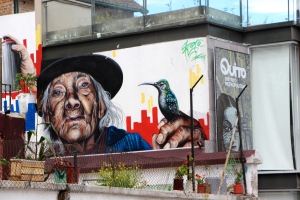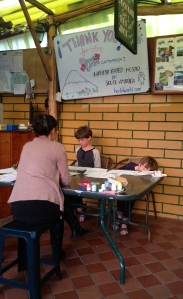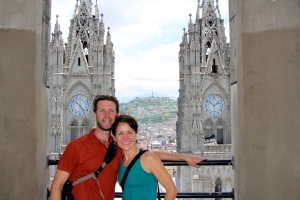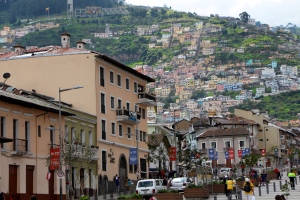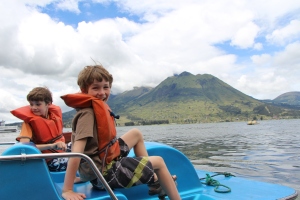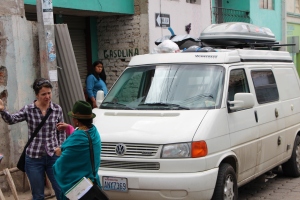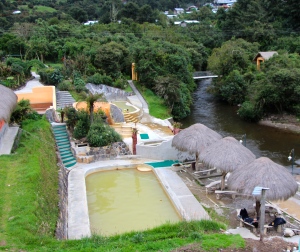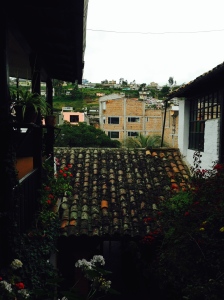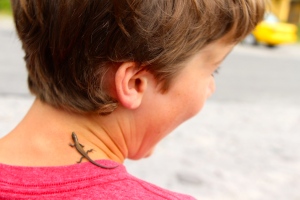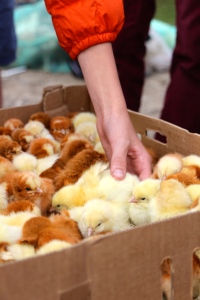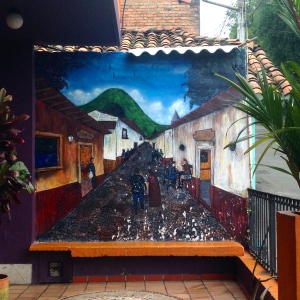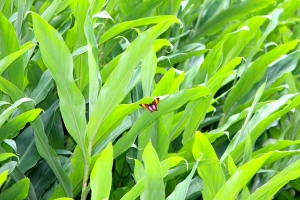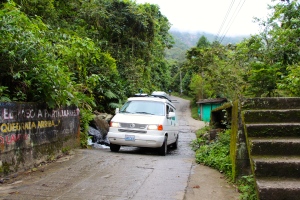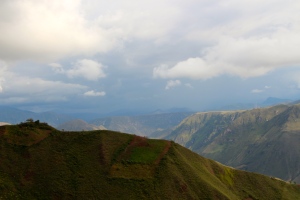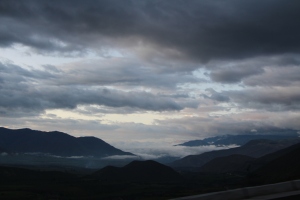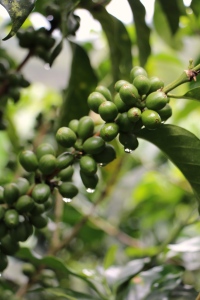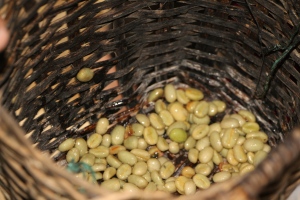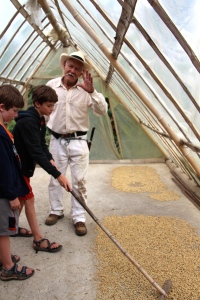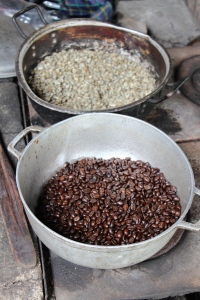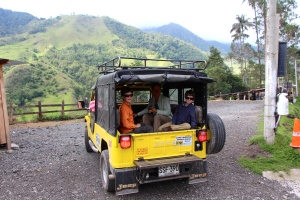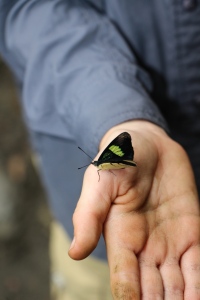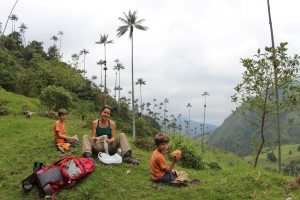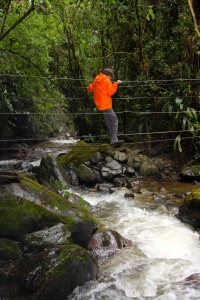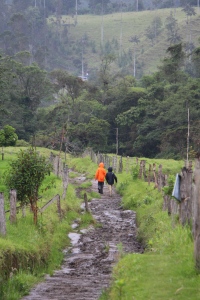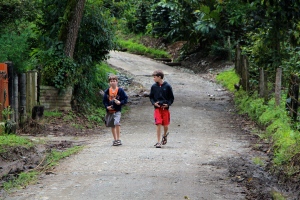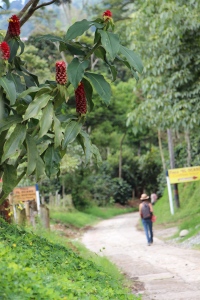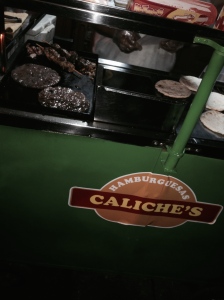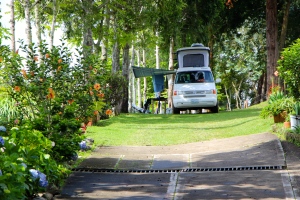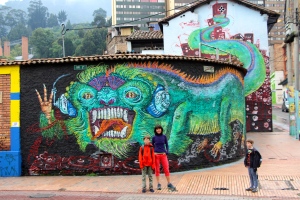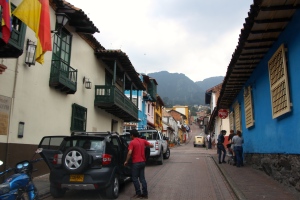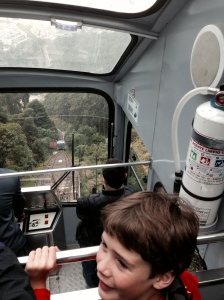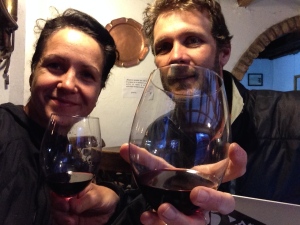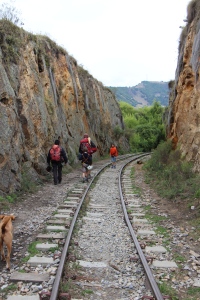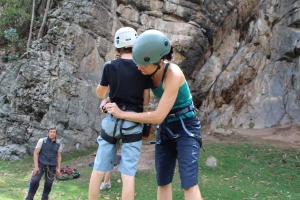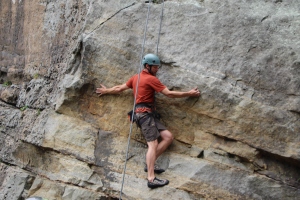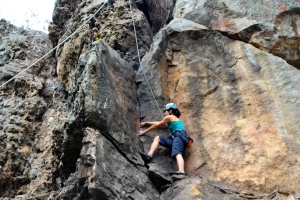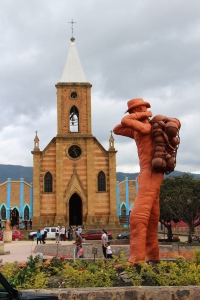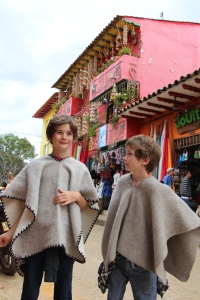Warning: some explicit content

We left San Gil on saturday, after Darin and the boys had a blast white river rafting the Rio Fonce. We weren’t sure how long the trip to El Cocuy would take, but our last glimpse of WiFi for what would be a week, told us that our window of opportunity for nice weather was limited to monday and tuesday (error #1).
A few hours into the drive, we were (legitimately) pulled over by the policia for speeding. After verifying our papers and asking us a dozen questions about where we came from, where we were going, how long we were planning on being in Colombia, they wanted details about our experience so far in Colombia…the police officer shook Darin’s hand and advised us to “control our speed”.
We pulled into the pueblito of Tuta at around 6:30pm with the intention of finding a camp and cooking dinner. As we rolled in on the town’s one and only main road, we found ourselves part of the saturday night festivities. Poncho wearing men with cowboy hats and horses were in the streets drinking beer, all while big slaps of beef were being smoked next to severed cow heads for sale.


We felt like we’d arrived in an alien ship and needed to at least announce that we came in peace. We parked and wandered down the main road, looking for dinner and a recommendation on where to make our camp.
Within 5 minutes, we were sitting at a small plastic table for 4 on the sidewalk in front a a family’s house. We were served a whole cold chicken, delicious boiled potatoes, and yucca, all of which we ate with our fingers.

We were quickly surrounded by drunken men who kept hugging Darin and calling him “Compadre”. They sang us songs and told us jokes which we couldn’t understand. Darin gave his new compadre his baseball hat as a “regalo”.

Apparently, with Colombia’s recent turmoiled past, camping has become a novelty. Even when we explain to people that our van is meant for camping and that all we need is a flat spot, somewhere quiet and ideally secluded, it’s like we’re asking to sleep on water. Most of the time, we’re sent to a hotel or the town plaza, which is usually in front of the church, next to the police station, under bright lights, with no seclusion whatsoever.
In Tuta, however, when I said secluded, they understood. The friendly woman whose table we sat at, sent her two boys ages 14 and 15 in our van with us so that they could show us the ideal place. We drove straight up for 15 minutes on a gravel road and found ourselves at the highest point around. The boys stayed with us for a while, they caught bugs that become dormant at night, they watched part of a movie with Simon and Marco on the laptop, and the oldest boy gave me his beaded red, blue and yellow “Colombia” bracelet. Eventually, someone showed up on a motorcycle to pick them up. We had a great night and spent the morning doing yoga and eating breakfast with a panoramic view of the valley below.
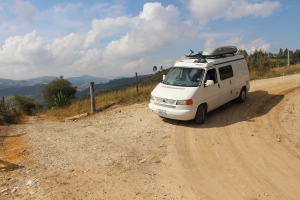
On our way out of Tuta the following morning, we stopped in to thank our hosts and say goodbye. A few hours into the windy drive, we found ourselves driving through a few towns which, not long ago were part of the FARC red zone. As always, we got many looks, but this time, the only plan was to pass through without stopping.
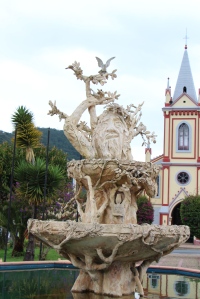
We drove over a total of 5 passes, each road, more washed out than the one before.

We got to the town of El Cocuy at 7:30pm, at 2700 meters, in the pouring rain, tired and hungry. We found a cozy room, had a typical dinner of rice, potatoes, and chicken and went to bed. We woke up refreshed on monday morning to an incredible view of the surrounding mountains.
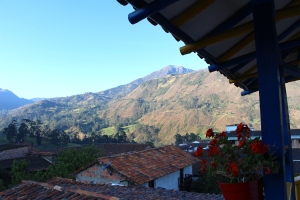
I mentioned that according to our online research 3 days prior, the weather would only hold up for us on monday and tuesday. From this point forward, many mistakes were made, which became dangerous and could have been disastrous. I share this turn of events to clear my mind and to share “what not to do”…
After our breakfast of potato soup and eggs, we headed to the Parque Nacional El Cocuy office to pay the entry fee and to register our route. On the way out, they require you to un-register, otherwise they send a search and rescue team. Being efficient and goal oriented as always, we chose a strenuous route which would take us to the Laguna Grande de la Sierra, a high lake. The park official told us that this 4 km hike would take 4 to 5 hours one way. This seemed feasible, it sounded like something we’d done over 100 times, plus we’d be camping at the lake and descending back the next day. The park official couldn’t tell us anything about the forecast and the only map available had no detail and no topographical information.
We drove up for an hour on a less than graveled road with ruts and pot holes that made our average speed less than 10 mph. By the time we got up to the trail head (which was actually a farmer’s hacienda), we were at 3600 meters. It was 11:30am and we felt pressed for time. We packed our food and camping gear in our backpacks and started straight up (error #2).

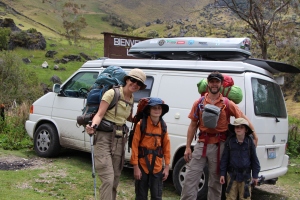
The first part of the hike was lovely and gradual through a farmer’s land, surrounded by cows and sheep.

At 0.7 km, we started hiking straight up through trees until we reached a beautiful, large meadow of Frailejon, at 4000 meters.


We welcomed the leveled .5 km through this meadow and started straight up once again, this time through nothing but rock. We climbed and climbed with no change in scenery.
At around 3:30pm, Simon started complaining of a headache. We took a third hydration and food break and continued on (error #3). By 4:30pm, we were exhausted and still far from our target. There was nothing but rock straight up and very few water sources. Behind us, the sky was almost black and roaring with thunder and lightning. The old man whose house we had parked at, had mentioned that that there was some sort of large rock shelter on the way to the high lakes. He must have known the forecast. Our goal became to find this rock shelter.
At some point about 45 minutes before we found our camp, Simon continued to complain of a severe headache and dizziness. We stopped at a small stream to have some electrolyte tablets in a water filled nalgene bottle. Darin’s eyes were blood shot, he was pale, and looking exhausted. We felt a bit crazy and in our delusion, we laughed at our current situation, which we would find out wasn’t funny at all. With Simon and I crying with fatigue, Marco, strong as a bull, led the way to the Cueva de los hombres. As soon as we saw it, we knew this was the cave the man had talked about. We climbed up to it, feeling saved for the night…not quite. Our elevation was approximately 4400 meters.
Somehow, we felt like once we stopped and had some hot soup and tea, we’d feel fine and get a great night’s sleep before finishing out hike the following day (error #4). The thunder continued, and it began to rain. As Darin filtered water, Simon was feeling and looking awful. I put all the clothes we had on the kids, including their down booties, inflated their mats and stuffed them into their sleeping bags. It was 5:45pm and they were out. Darin and I set up camp and we proceeded to make the soup, still thinking somehow that this would solve everything.

Cueva de los hombres
Darin had borrowed our friend Mick’s multi fuel camp stove, which, unlike ours, can burn fuel at high elevations. Having not found white gas, Darin had filled the canister with dirty unleaded gas. The orifice for the burner kept getting clogged, Darin changed it for a larger one. To ensure the continuation of the flame, Darin apparently over pressurized the tank to try to clear the jet. The stove and tank caught fire and Darin managed to throw it 15 feet away as we ducked and screamed at the kids to get behind a rock for fear that it would explode. It never did explode, but continued to burn for a few minutes as I stood there shaking.
Luckily, before we burned up all of our fuel, Darin had managed to boil a pot of water. I threw in our soup and let it sit until it became edible. We got the kids out of the tent so they could eat, hydrate and feel better. Within having a few bites of soup, they were both vomiting. That’s when it hit us…What the f*#@ had we done?!?
We did manage to get the kids to eat and drink a bit but all they really wanted to do was sleep. By 7:30pm we were all in the tent, the kids sleeping and Darin and I trying to focus through the headache, nausea and shortness of breath. I felt panicked and wanted to descend immediately regardless of the dark and fatigue. Darin convinced me that it would be very dangerous to descend but that if things became very urgent, we’d leave all our gear in the cave and descend with headlamps. Sure enough, within an hour we were heavily clouded in and couldn’t see a foot ahead of us. We spent the night waking the kids up every half hour to hydrate them, check their vitals and to make sure they were coherent.
At sunrise, Darin packed our stuff as the kids and I sat watching, dizzy, sick, and with bluish lips. The descent took about 3.5 hours. The dizziness got better fairly quickly but the headache and nausea took several hours to go away once we were back in the town of El Cocuy. We ate and slept our way through the afternoon and night. On the following day, feeling defeated, we anxiously headed out of El Cocuy.

About one minute out of town, Darin stopped the van and said “I think we need to stay here a few more days and we need to do another hike”. The kids and I sat there and stared at him open mouthed. He proceeded to explain that if we didn’t do it, we’d forever feel disgusted with our El Cocuy experience. Having spent the entire previous night reliving our experience in the cave, I knew exactly what he meant and I agreed. We promised the kids that this time, we’d have a beautiful experience. Being incredible boys, they agreed, with the condition that we’d watch a movie together that night…the deal was sealed.
We went to the town market and gathered all the necessary ingredients to make a chicken rice soup from scratch. We headed back up the difficult road to a different park entrance, where we were told we could find an easy 8km round trip hike to the Lagunillas, a group of three lakes. We drove down a horrific road for about a kilometer and ended up in spot that was completely deserted, except for the local sheep and horses.
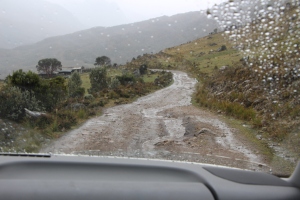
Our 11,500 ft high camp was so remote that we felt like we were in the backcountry but camping in our van. We spent the entire day reading, playing with the horses, gathering water form a nearby spring, and cooking our soup. We watched the movie Rango and had many servings of our amazing soup. We slept like babies…well, actually, I once again relived every moment in the cave.

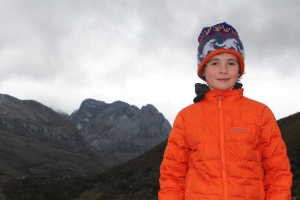

camp robber


The following morning, Luis Alejandro Herrera, a local gaucho arrived, as scheduled, arrived with 2 horses for the boys. He enjoyed a bowl of granola and a coffee with us in silence, as we marveled at the day before us. We were acclimated to this elevation and we felt great.
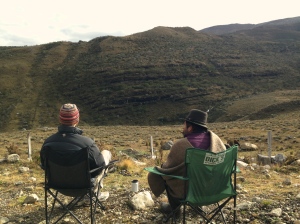

Luis Alejandro and I hiked the 8 km while the boys enjoyed the cozy ride on horses. The scenery was magnificent, the weather was beautiful, and the 12,600 foot elevation felt perfectly fine.

Darin took a different route and climbed to 16,000 feet to the El Pulpito glacier, which helped get the ants out of his pants.
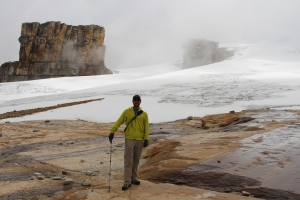
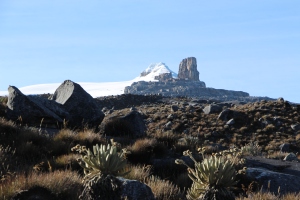
El Pulpito del Diablo
We met back at the van in the early afternoon, where Simon and I climbed down to the beautiful river below us to fly fish.
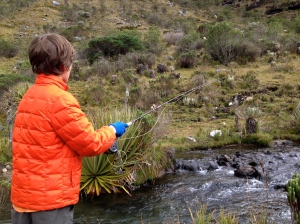
With no fish to eat for dinner, and the road back up on Darin’s mind (he had spent the previous night up, with sweaty palms, fearing the road back up), we left camp and started the crazy climb up the road. For fear of falling off a cliff, the kids and I got out of the van and watched it gyrate and slide backwards 5 times on a switchback on it’s way up the road. When we made it to the top of the hill, Darin got out of the van, was very red in the face and had a look of pure exhilaration and relief.

We headed back down to the town of El Cocuy, which by now was very much growing on us. The town of El Cocuy brings about “what if we moved here and made cheese for a living” kinds of conversations.
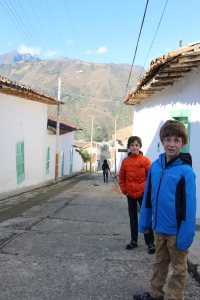
We spent a third night in the hostel that we came to equate with warm showers (rare in Colombia) and comfort. We had our daily granola with fruit breakfast in the van and shared our coffee with a police officer who seemed to cherish every sip.

a plug for REI?
We went to the weekly friday market and bought the kids “fresh” cotton candy. It was as though we’d taken them to Disney Land. We left El Cocuy feeling fulfilled and much better than we did on our first attempt at a departure.
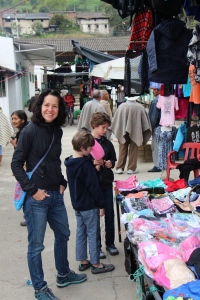
friday market in El Cocuy
Having had time to digest our experience, we’ve come to the realization that everything came down to the notion of a time constraint. We’d driven nearly 3 days to get here darn it! We’re so use to being goal oriented, to getting the job done, to being in “go” mode. We’re so wrapped up in the idea of a plan and a schedule. We should have spent an extra day in the town of El Cocuy, a full day and night at the trail head, and then we should have turned around immediately at the first sign of Simon’s symptoms.
This was a learning experience which has rendered us embarrassed, humbled, and grateful.
On the way toward Villa de Leyva, we stopped for lunch and were unknowingly fed tripe soup thinking it was chicken. We still feel a bit queasy thinking about it. We spent yet another night at the hill top in Tuta, where I made burritos and the kids amused themselves by burning long blades of grass, which they pretended were hobbit pipes.

We’ve made it to Villa de Leyva, and it’s a bit of a warped dimension, coming from the poncho wearing, horse straddling, formal speaking town of El Cocuy. We’ve already eaten chicken wings, tofu, and Arugula pizza. It’s a welcomed pampering for us all and we’re going to revel in it for a few days.

